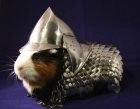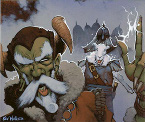JohnDillworth
Posts: 3100
Joined: 3/19/2009
Status: offline

|
quote:
ORIGINAL: Canoerebel
Trees are "right in my wheelhouse" (using a baseball term). I have a degree in forestry. Here's some information along the lines of what you guys posted. This comes from ol' memory, not Google:
The sprout trees with the green leaves are southern red oak (Quercus falcata). Juvenile leaves are notoriously difficult to identify in the oak species. They can be a-characteristically oversized or misshapen compared to the adult leaves. But this one is very distinctive. The base of the leaf is the real giveaway. Notice how it's almost bell-shaped? And the tips are actually fairly pointed rather than distinctly rounded, as you'd find with a white oak. Juvenile white oaks leaves are generally pretty characteristic of the adult leaves. But this is a pretty easy call - these leaves are almost identical to mature southern red oak leaves.
American chestnut (Castanea dentata) was nearly wiped out by chestnut blight, beginning in 1904 in New York City and spreading south through the 1940s. The tree survives, but mostly by sprouting from old root stock. Usually, the sprouts are killed before they reach nut-bearing size, though occasionally the trees are able to reproduce. Spanish chestnut and Chinese chestnut are resistant to the blight and have been widely planted in the USA. They are inferior trees, in terms of size and quality of wood and nut. You probably are enjoying one of those species. The American Chestnut Society and various educational and research groups have been crossbreeding American chestnut with the resistant varieties for forty years or longer. They now have hybrids that are something like 15/16th American (going from very old memory there) that have the desired resistance to survive in the wild. These hybrids are far superior to the non-native species and close to the original species. I think they are available for sale. There is an acre-sized plot at our local Berry College with young trees perhaps 20 years old. The American Chestnut Society is located somewhere in southwestern Virginia (Roanoke or Blacksburg?).
Persimmon (Diospyros virginiana) fruits only taste better after frost or temperature drop purely by coincidence. The ones I enjoy in August and September taste just as good as the ones I eat in October and November. The wood of persimmon is very hard, very dense, shock resistant, dark and beautiful. It was used for the old "wood" heads on golf clubs.
Southern dogwood (Cornus florida) was hit hard by dogwood anthracnose beginning around the 1990s. The disease (I don't know if it's a fungus or something else) seemed to arrive here but then disappear. As best I can tell, the southern dogwood population in northwest Georgia is as high as ever. The wood of dogwood is very hard and dense. In fact it's the second densest wood in North America, trailing only live oak (which Old Ironsides was made of, largely). Dogwoods don't get big enough to provide lumber, but the dense wood was used for specialty items, especially the old loom shuttles in textile mills. Also, children's toys.
Eastern redbud (Cercis canadensis) is a member of the legume family. The pretty lavender flowers are edible and taste distinctly like raw peanuts. Redbuds are small trees. Legend is that Judas Iscariot hung himself from a redbud (I think a European or Asian member of the redbud family), thus dooming the tree to it's short status.
Edited to correct typo (I couldn't let "dentate" remain uncorrected).
quote:
American chestnut (Castanea dentata) was nearly wiped out by chestnut blight, beginning in 1904 in New York City and spreading south through the 1940s. The tree survives, but mostly by sprouting from old root stock. Usually, the sprouts are killed before they reach nut-bearing size, though occasionally the trees are able to reproduce. Spanish chestnut and Chinese chestnut are resistant to the blight and have been widely planted in the USA. They are inferior trees, in terms of size and quality of wood and nut. You probably are enjoying one of those species. The American Chestnut Society and various educational and research groups have been crossbreeding American chestnut with the resistant varieties for forty years or longer. They now have hybrids that are something like 15/16th American (going from very old memory there) that have the desired resistance to survive in the wild. These hybrids are far superior to the non-native species and close to the original species. I think they are available for sale. There is an acre-sized plot at our local Berry College with young trees perhaps 20 years old. The American Chestnut Society is located somewhere in southwestern Virginia (Roanoke or Blacksburg?).
One of my greatest surprises whilst hiking through the woods in the Shawangunk Mountains near New Paltz was a stand of American Chestnuts. They were about 10 feet high. I understand they usually get the blight and start to die off when they get about this size. Governors Island, In New York Harbor, has a number of hybrid American Chestnuts. They are small, but we hope for the best. Forest change over time. When I was a kid we used to jump the fence and swim in one of NYC's reservoirs. The City no longer used these reservoirs, and after a couple of kids drowned this particular reservoir was drained. Maybe 30 years ago. First weeds grew, they some mulberry and swamp grass. Then some pines and locust. Now, 30 years in, the hardwood oaks and maples are starting to grow. Forests change
_____________________________
Today I come bearing an olive branch in one hand, and the freedom fighter's gun in the other. Do not let the olive branch fall from my hand. I repeat, do not let the olive branch fall from my hand. - Yasser Arafat Speech to UN General Assembly
|
 Printable Version
Printable Version























 Commands don't seem to matter, at least in any game I played.
Commands don't seem to matter, at least in any game I played.


 New Messages
New Messages No New Messages
No New Messages Hot Topic w/ New Messages
Hot Topic w/ New Messages Hot Topic w/o New Messages
Hot Topic w/o New Messages Locked w/ New Messages
Locked w/ New Messages Locked w/o New Messages
Locked w/o New Messages Post New Thread
Post New Thread